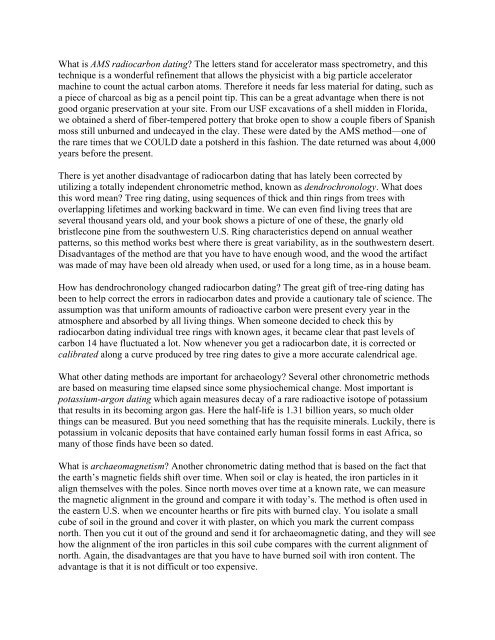INTRODUCTION TO ARCHAEOLOGY Nancy White - Touro Institute
INTRODUCTION TO ARCHAEOLOGY Nancy White - Touro Institute
INTRODUCTION TO ARCHAEOLOGY Nancy White - Touro Institute
Create successful ePaper yourself
Turn your PDF publications into a flip-book with our unique Google optimized e-Paper software.
What is AMS radiocarbon dating? The letters stand for accelerator mass spectrometry, and this<br />
technique is a wonderful refinement that allows the physicist with a big particle accelerator<br />
machine to count the actual carbon atoms. Therefore it needs far less material for dating, such as<br />
a piece of charcoal as big as a pencil point tip. This can be a great advantage when there is not<br />
good organic preservation at your site. From our USF excavations of a shell midden in Florida,<br />
we obtained a sherd of fiber-tempered pottery that broke open to show a couple fibers of Spanish<br />
moss still unburned and undecayed in the clay. These were dated by the AMS method—one of<br />
the rare times that we COULD date a potsherd in this fashion. The date returned was about 4,000<br />
years before the present.<br />
There is yet another disadvantage of radiocarbon dating that has lately been corrected by<br />
utilizing a totally independent chronometric method, known as dendrochronology. What does<br />
this word mean? Tree ring dating, using sequences of thick and thin rings from trees with<br />
overlapping lifetimes and working backward in time. We can even find living trees that are<br />
several thousand years old, and your book shows a picture of one of these, the gnarly old<br />
bristlecone pine from the southwestern U.S. Ring characteristics depend on annual weather<br />
patterns, so this method works best where there is great variability, as in the southwestern desert.<br />
Disadvantages of the method are that you have to have enough wood, and the wood the artifact<br />
was made of may have been old already when used, or used for a long time, as in a house beam.<br />
How has dendrochronology changed radiocarbon dating? The great gift of tree-ring dating has<br />
been to help correct the errors in radiocarbon dates and provide a cautionary tale of science. The<br />
assumption was that uniform amounts of radioactive carbon were present every year in the<br />
atmosphere and absorbed by all living things. When someone decided to check this by<br />
radiocarbon dating individual tree rings with known ages, it became clear that past levels of<br />
carbon 14 have fluctuated a lot. Now whenever you get a radiocarbon date, it is corrected or<br />
calibrated along a curve produced by tree ring dates to give a more accurate calendrical age.<br />
What other dating methods are important for archaeology? Several other chronometric methods<br />
are based on measuring time elapsed since some physiochemical change. Most important is<br />
potassium-argon dating which again measures decay of a rare radioactive isotope of potassium<br />
that results in its becoming argon gas. Here the half-life is 1.31 billion years, so much older<br />
things can be measured. But you need something that has the requisite minerals. Luckily, there is<br />
potassium in volcanic deposits that have contained early human fossil forms in east Africa, so<br />
many of those finds have been so dated.<br />
What is archaeomagnetism? Another chronometric dating method that is based on the fact that<br />
the earth’s magnetic fields shift over time. When soil or clay is heated, the iron particles in it<br />
align themselves with the poles. Since north moves over time at a known rate, we can measure<br />
the magnetic alignment in the ground and compare it with today’s. The method is often used in<br />
the eastern U.S. when we encounter hearths or fire pits with burned clay. You isolate a small<br />
cube of soil in the ground and cover it with plaster, on which you mark the current compass<br />
north. Then you cut it out of the ground and send it for archaeomagnetic dating, and they will see<br />
how the alignment of the iron particles in this soil cube compares with the current alignment of<br />
north. Again, the disadvantages are that you have to have burned soil with iron content. The<br />
advantage is that it is not difficult or too expensive.
















